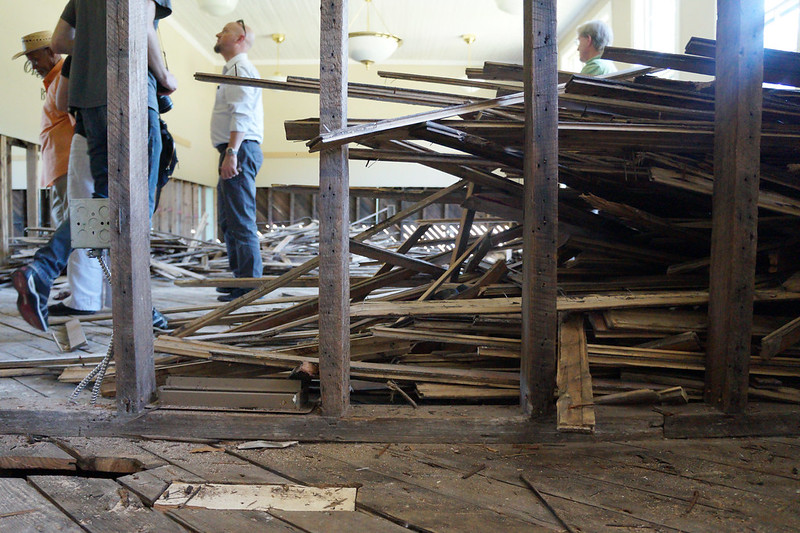By Sarah Lipuma and Margaret Benson Nemitz
Amanda Martin, Deputy Chief Resilience Officer for the state of North Carolina, came to speak to our class for the UNC Natural Hazards Resilience Speakers Series on Jan. 23.
Martin engaged the room by asking us what we would do with $500 million to distribute as the state’s new resilience officers. Some students suggested doing studies on the public health impacts of frequent flooding; others thought of specific infrastructure improvements to reduce flooding; and one recommended making sure that rebuilding jobs went to unemployed local community members first. The students, from UNC’s Planning and Public Health programs, as well as Duke’s Nicholas School of the Environment, needed no help thinking up hard-hitting questions for this experienced natural hazard planner.
Martin was speaking as part of the Natural Hazards Resilience Speaker Series, which brings experts to campus to speak to Natural Hazards Resilience certificate students annually during the spring semester. A former student in these same certificate courses, Martin focuses on housing issues at the North Carolina Office of Recovery and Resiliency (NCORR), a relatively new statewide office established to aid in recovery from multiple recent hurricanes. Her office administers federal funds from the U.S. Department of Housing and Urban Development through the Community Development Block Grant – Disaster Recovery Program. While mitigation grants from the Federal Emergency Management Agency are distributed by the North Carolina Department of Emergency Management, when it comes to getting residents the help they need after a disaster strikes, the two state departments try to make their programs as streamlined as possible to avoid complicating the recovery process.
NCORR is endeavoring to expand the stock of safe and affordable housing to help communities adapt to the problems caused by natural disasters and climate change impacts. North Carolina has helped survivors of Hurricanes Matthew (2016) and Florence (2018) by spending $3.3 billion in state and federal funding on mitigation and recovery work. Mitigation grant funding is primarily awarded to homeowners of low to moderate income.
The state of North Carolina wants to build back smarter after natural disasters, she said. When it funds projects to build new houses for people who lost their homes to flood damage, the homes are built 2 feet higher than the flood of record instead of 2 feet higher than the 100-year flood level. Going beyond minimum requirements for safety is the right thing to do, she said, to make at-risk communities more resilient.
Through a resilience planning project, Martin hopes to help create regional collaborations at the watershed scale to increase local community capacity to prepare for natural disasters. Other ideas within this project are to fund training for emergency managers, engineers and town planners on how to develop a portfolio of resilience projects, and to look into nature-based solutions to flooding like living shorelines and increased wetlands restoration. These solutions would expand the capacity of the landscape to soak in floodwater instead of trying to keep water out with hard infrastructure like concrete revetments and seawalls.

Floodwaters from Hurricane Matthew (2016) surround many houses in Craven County, N.C. Photo by Jocelyn Augustino/FEMA.
Martin spoke to us about the property buyout process in North Carolina. The buyout program, much like the general mitigation grant funding process, is completely voluntary and focused on low- to moderate-income homeowners. Eligible property owners apply for a buyout and if they meet all the requirements, the property is purchased by the state for the pre-disaster fair market value. NCORR gives an incentive of $5,000 on top of that if the homeowner moves to a safer area within the state, and $10,000 if the homeowner moves within the same county. The state then demolishes buildings and infrastructure and allows the land to return to a natural condition.
This discussion made me compare the buyout process in North Carolina to that of my home state, New Jersey. New Jersey’s Blue Acres Floodplain Acquisition program uses dedicated state funding, staff and resources, as well as federal grant money when available, to conduct buyouts on behalf of local communities. Because of this, a buyout usually takes only 6 to 12 months from application to home purchase, with demolition and restoration of the property within a year after that.
North Carolina’s property acquisition process could be improved by modeling the program after Blue Acres. The dedicated funding source enhances the program’s continuity of work and ability to base decisions not just on the availability of federal grants after major disasters. Blue Acres has also created partnerships with universities in the state to restore and beautify the newly created open space after a buyout so that it has the maximum amount of benefits as a floodwater retention area while being amenable to community use as a recreation area.

Princeville, N.C., officials give a tour of the damage to the town museum, which was damaged by Hurricane Matthew. Photo by Jessica Southwell.
The tangled web of housing resilience, equity, and decision-making
Martin shared information about the ReBuild NC hurricane recovery programs, administered by NCORR, and emphasized the organization’s focus on serving the state’s most impacted and distressed areas and households. As a public health student interested in health equity, I was inspired by all that ReBuild NC is doing to address inequities; however, I was also struck by how funding mechanisms and timing can inhibit residents’ options and agency in recovering from natural hazards and increasing resilience of their homes.
Per funding requirements, 70% of ReBuild NC’s funds have to meet needs of low-to-moderate income households. ReBuild NC is going above and beyond to reach households who are most in need of their services within six counties that have been identified as the most impacted and distressed areas, awarding 77% of their funds to low-to-moderate income households. I was interested to learn that of the six priority areas, ReBuild NC had to advocate for two of them to be recognized and added to the list. The way that Martin explained the process makes it sound like the original list of four priority areas were determined through a more formulaic, large-scale process. It is often easy for systems to overlook marginalized areas when looking at birds-eye-view patterns, especially when many of the structures and systems in our society operate from oppressive histories. I am encouraged to hear that the Office of Resilience and Recovery is involved with communities on-the-ground to identify additional priority areas that may otherwise be missed by the calculations for most impacted and distressed.
Through ReBuild NC’s housing recovery and buyout programs, the Office of Resilience and Recovery is doing impressive work to truly improve resilience while also providing the post-disaster recovery services that homeowners need, all focusing on the most impacted areas. While listening to Amanda, I realized that by the time the funding becomes available and homeowners hear about these options, it may be too late – homeowners may have already had to make choices about how to recover from disasters, preventing them from benefiting from the buyout and rebuild services. Yet, as she brought to our attention, this timing can be really tricky, as it is also critical that these programs, particularly buyouts, aren’t presented in ways that become coercive or predatory.
I was also struck by how funding mechanisms and timing can inhibit residents’ options and agency in recovering from natural hazards and increasing resilience of their homes.
How can recovery and resilience organizations meaningfully communicate all options to homeowners following a disaster? What options exist for homeowners during the months-to-years of waiting for funding to come through for programs such as buyouts? And how are we supporting renters? In public health, we talk a lot about empowering individuals and communities to be able to decide what is best for their health. Knowing your options and being able to decide how to proceed after being impacted by a natural disaster is certainly a health decision, yet until Martin’s presentation, this wasn’t on my radar.
I was impressed to hear how NCORR’s case managers support homeowners throughout the recovery process and address the many ways in which it impacts mental health. I am encouraged by the holistic approach that ReBuild is taking on an environmental, community and individual level.
The ReBuild NC website includes additional homeowner guidance documents and information about the national flood insurance program.
Sarah Lipuma is a first- year Master of Environmental Management student at the Nicholas School of the Environment at Duke University. She researches climate change risk mitigation strategies for coastal communities.
Margaret Benson Nemitz is a second- year Master in Public Health student in the Health Behavior department at UNC-Chapel Hill. She focuses on how local public health can more meaningfully communicate to and engage with communities in public health-related decision making to improve health equity.


